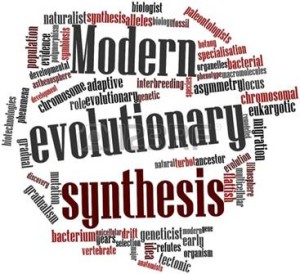Some notes on the first half of Chapter 4, Evolution of the Theory…
The center holds
Darwin’s theory has held through many empirical testings, and today there is no reasonable scientific conflict about the theory. Scientists have noted key features that characterize evolution as a whole: kinship; novelty; cumulative body relationships – and a propensity, over time, to produce beings of ever more complicated structures by elaborating on simpler structures that already exist.
Misuse of the theory
But before long, Darwin’s theory became a resource for political and social causes, whose advocates tried to turn a biological theory into a script for human society. The fatal flaw lay in transferring a scientific theory about a biological process (that happens without conscious intent) to the arena of human interaction (where causes are intentional, willful, and complex.)
Social Darwinism: Once the fifth edition of Origin adopted the phrase ‘survival of the fittest’ the book’s thesis was unfortunately linked with Herbert Spencer’s philosophy of inevitable progress, making winners of some human beings and losers of others. By the 20th century, these ideas were gathered under the label ‘Social Darwinism’. The eugenics movement drew on these views; so did practices of discrimination against certain racial groups.
Darwin himself, while acknowledging a concern for the poor, weak and unfit, saw the need for the gifted to succeed in society. Thus he did not explicitly oppose the connection some were making between evolutionary theory and social policy, and he even tended in some of his later writings to contribute to a new way of justifying prejudice. But his ideas are descriptive of the evolution of life, not normative for intentional human behavior.
Scientific advances
In Darwin’s day, there was as yet no field work on which to draw; hence some of the precise details of his explanation have not held up – but he painted the core picture that still guides scientists’ work.
The laws of heredity: Between 1856-1863, Gregor Mendel’s experiments with pea plants led to the discovery of dominant and recessive genes, and to the conclusion that hereditary traits are passed on intact, one pair from each parent. Mendel’s laws of heredity are the foundation of genetics, and the theory of evolution received a major boost when the laws of heredity were wedded to Darwin’s own work. In Origin Darwin had lamented his ignorance of the laws of reproduction; now the explanation was found. Referred to as the modern synthesis or neo-Darwinism, this understanding was later deepened by the discovery of the double helix structure of DNA.
DNA: Many people believe that biologist James Watson and physicist Francis Crick discovered DNA in the 1950s, but it was actually first identified in the late 1860s by chemist Friedrich Miescher. In the decades following Miescher’s discovery, other scientists carried out a series of research efforts revealing additional details about the DNA molecule, including its primary chemical components and the ways in which they joined with one another. Without the scientific foundation provided by these pioneers, Watson and Crick may never have reached their groundbreaking conclusion of 1953: that the DNA molecule exists in the form of a three-dimensional double helix.
The Modern Synthesis:
evolution by natural selection + genetic theory + its molecular detail
The modern synthesis: By the 100th anniversary of Origin, the modern synthesis was firmly established. The modern synthesis and its investigative branches have updated the core theory of evolution, keeping its explanatory power relevant and fresh.
• Speed: One major change concerns the length of time required for evolution to occur. While Darwin wrote numerous times, “Evolution does not make leaps,” biologists now understand that the process sometimes happens much more quickly.
• Catastrophe: By the late 20th century geologists and paleontologists were convinced that there had been at least 5 mass extinctions in earth’s history. Thus while Darwin was right about the gradual extinction of species in general, there are exceptions to his single causal theory.
• Rhythm: Darwin concluded that evolution happens continuously by a series of slow, steady transformations. The theory of punctuated equilibrium holds that evolution is characterized by long periods of stability or equilibrium, punctuated by episodes of very fast development.
• Struggle: Evolution will occur as long as there are variations in a species. But factors other than struggle are also involved – a species’ integration with its environment, efficient of utilization of food, better care of the young, and cooperative social organization.
• Plate tectonics: With understanding of plate tectonics and its influence on species, we now know that migration of species took place in a much wilder way than Darwin’s explanation for the distribution of species.
• Different life forms: Certain bacteria don’t reproduce in the usual manner, instead recombine a fraction of their genome with the genomes of others. This lateral gene flow makes it difficult to identify independent species among the bacteria. A different pattern of evolutionary relationship needs to be figured out.
On many fronts scientific discoveries have strengthened Darwin’s insight that human beings, too, have come into being as a result of descent with modification. (Two of his later major works sought to demonstrate human evolution in detail.) While the precise details of Darwin’s explanation have not always held up, recent discoveries in paleontology, comparative anatomy, developmental biology and genetics are adding new specificity to the core picture Darwin painted.
To add your comments or questions,
click on ‘Leave a Reply’ or ‘Replies’ (below).

